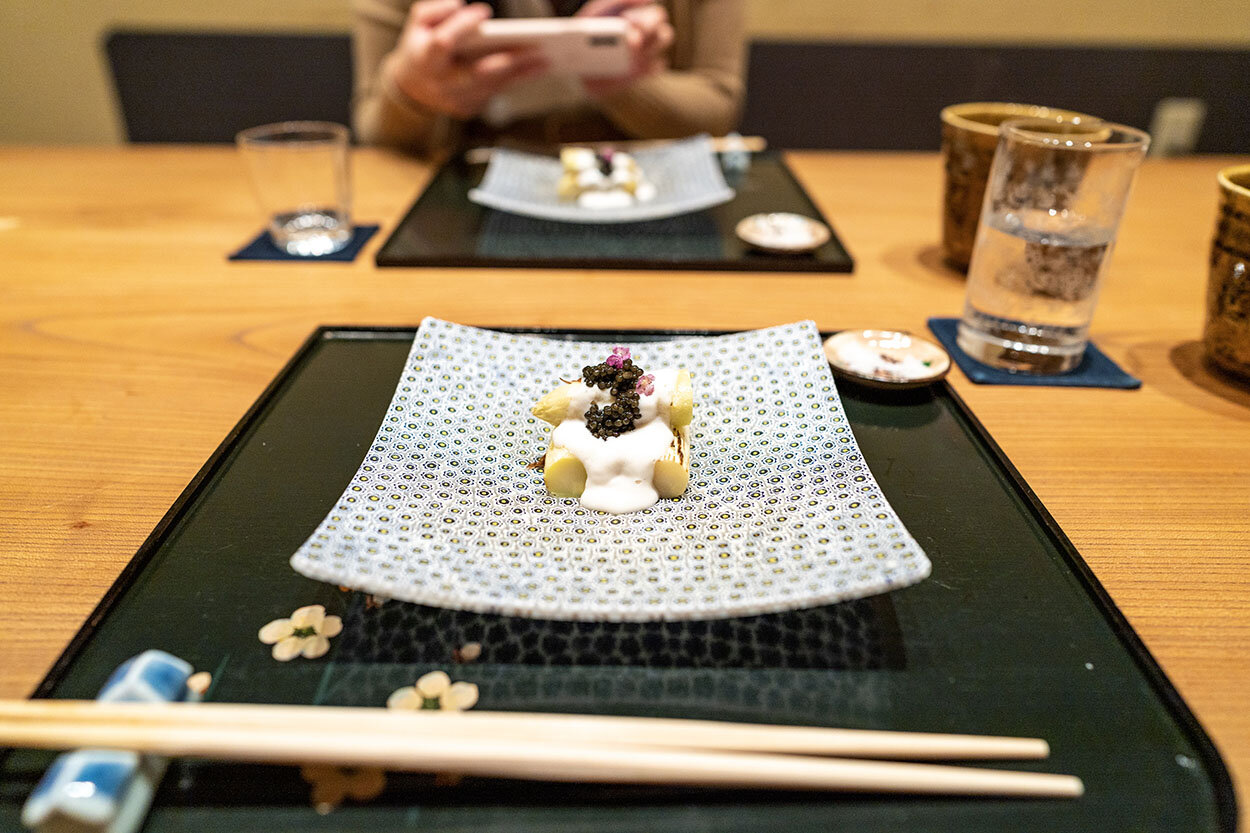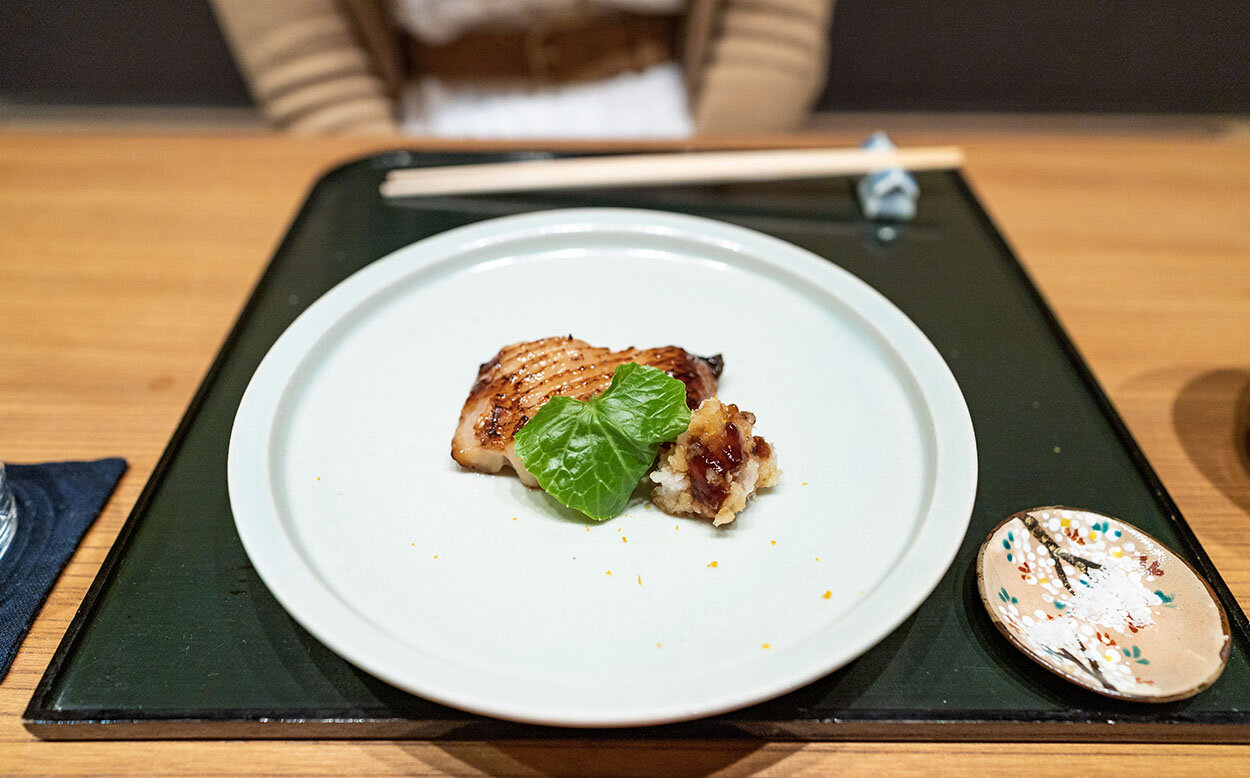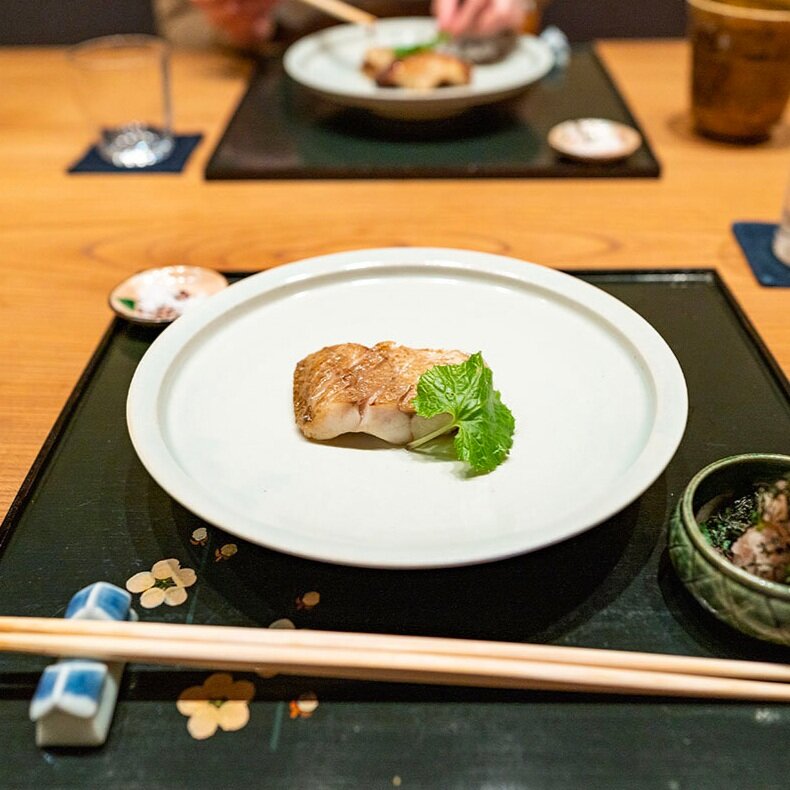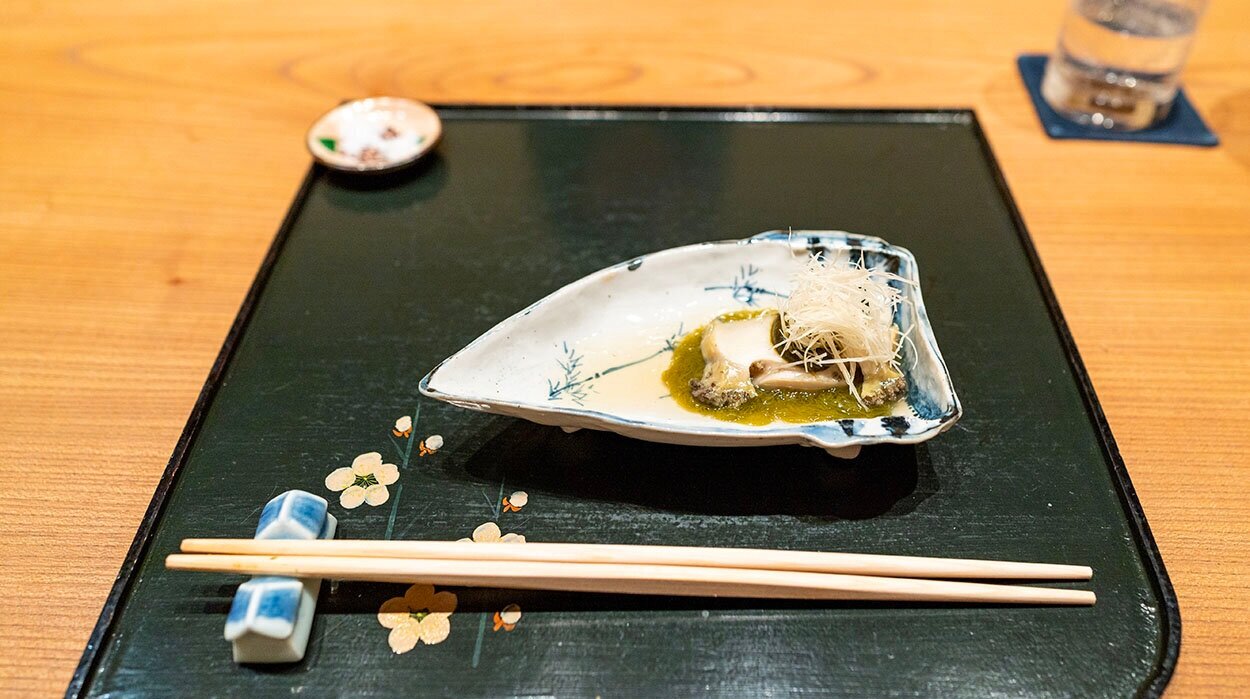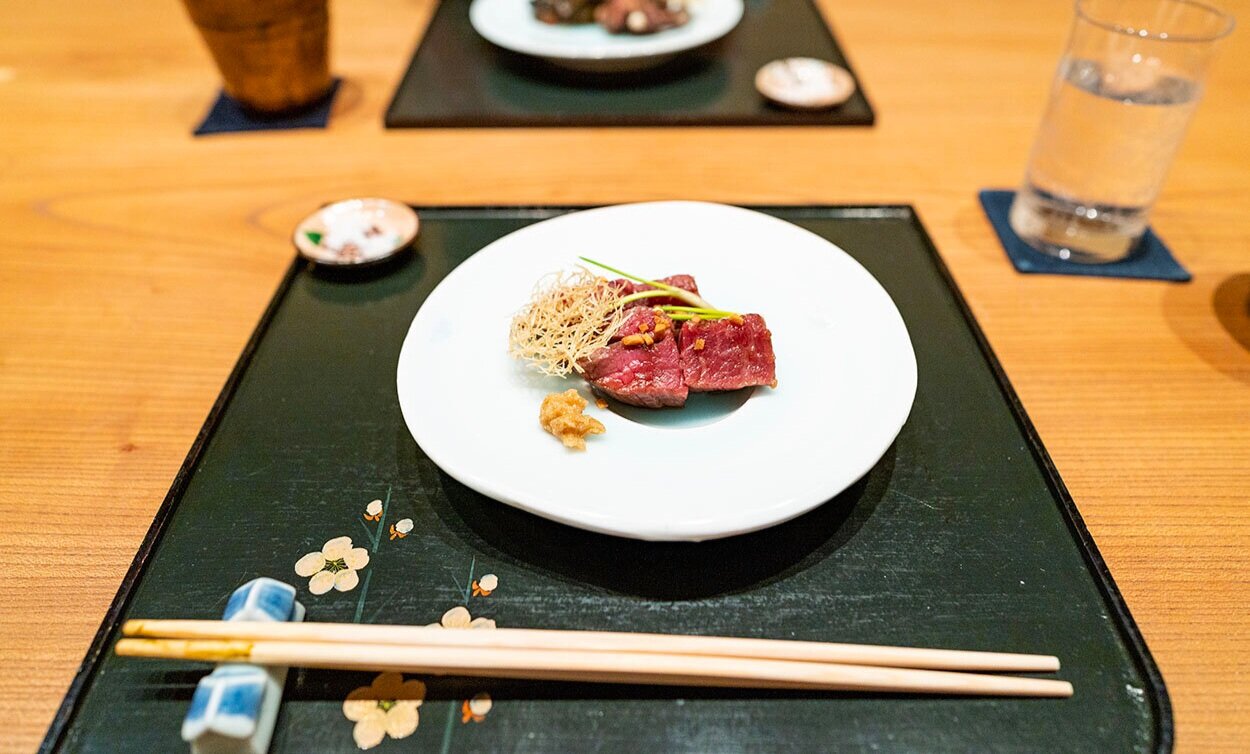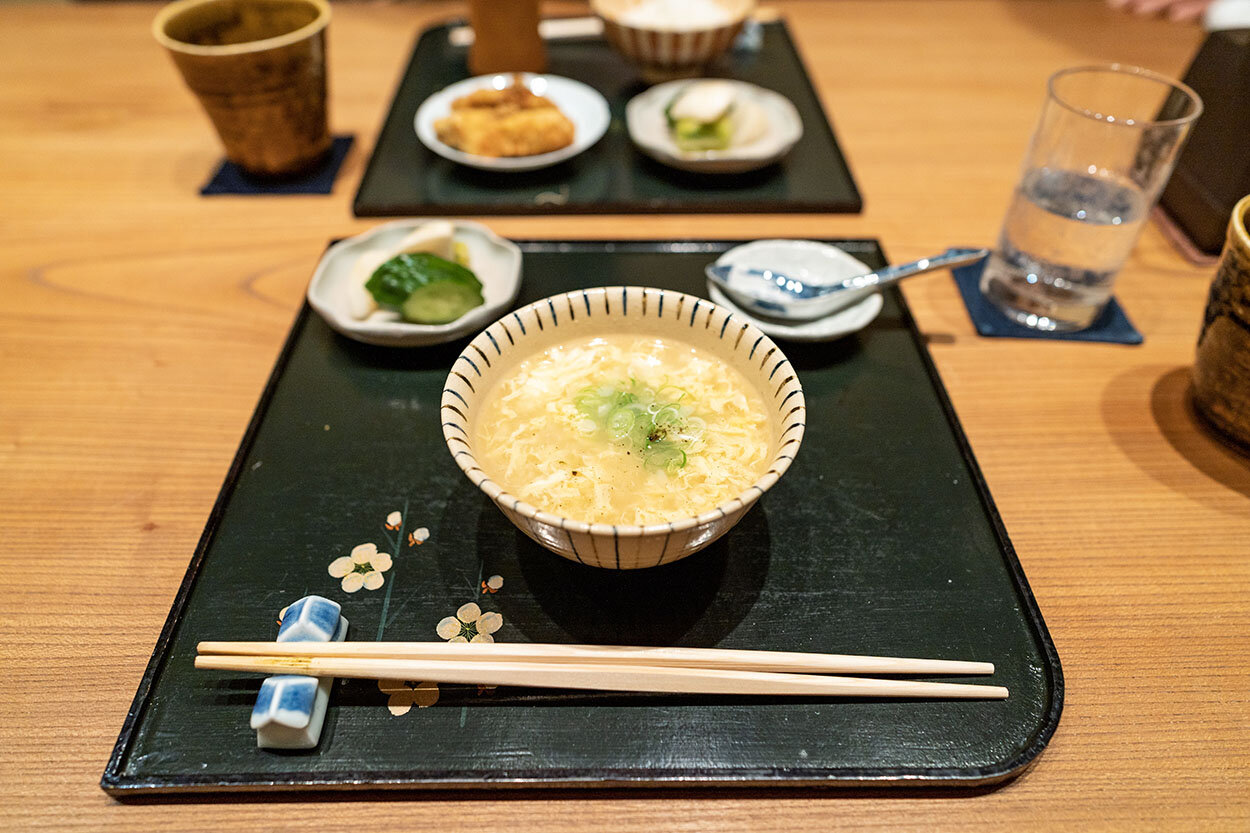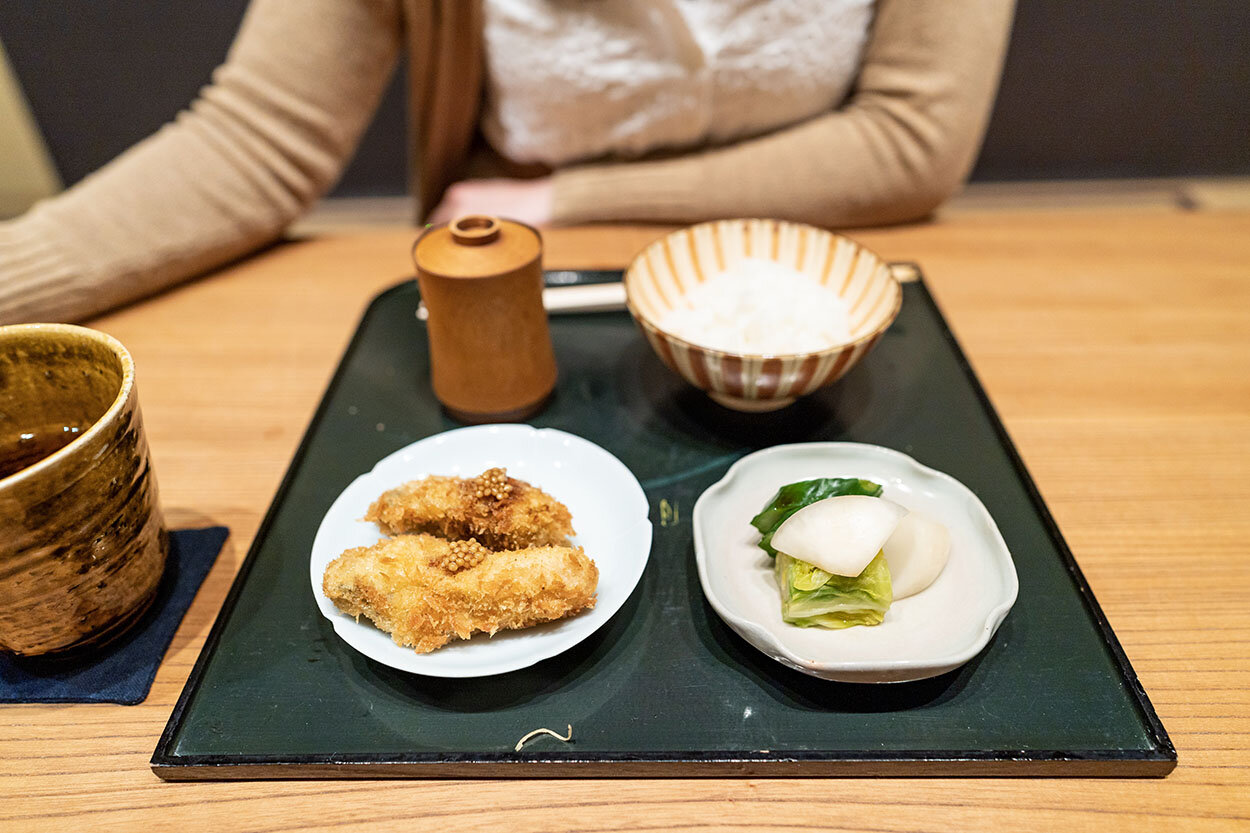Ifuki
Kaiseki Kissed By Fire
When Chef Norio Yamamoto decided to set off toward opening his own restaurant, his journey took him first to Spain. It was in Spain that he learned more about cooking techniques that utilized a charcoal grill to enhance flavor. Upon returning to Japan, Chef Yamamoto went on to open one of the first high-end restaurants in the country that focused on charcoal grill cooking.
Ifuki combines sumibiyaki (“charcoal grill cooking”) with the principles of kaiseki cuisine. The menu generally follows the typical progression of high-end kaiseki meals I’ve had in the past, but at Ifuki each course featured at least one element that was prepared using the charcoal grill. Given it’s uniqueness and 2-Michelin star rating, reservations can be hard to come by. Most diners will opt to sit at the counter, overlooking Chef Yamamoto and his charcoal grill, but Ifuki does have a few small private rooms.
Choose Your Own Adventure
As with most kaiseki meals, Ifuki serves a set menu with a traditional progression. However, unlike most restaurants of this type, Ifuki does provide you with three different decisions – choice of fish, choice of main entree protein, and choice of rice course – that will tailor your meal to your preference. Since there were two of us, I got to try a variety of different options as Judy and I selected different choices for each of the three courses.
Hassun course - Assorted small dishes including ayu, octopus, unagi, fish roe, and crab
Kaiseki meals traditionally start with a hassun course (or sometimes with a small amuse bouche type course). This course features a few small dishes that incorporate seasonal ingredients. For this hassun we had a variety of seafood-centric dishes. The charcoal grill item here was the unagi, who’s fatty flavor paired well with the smokey flavor of the grill.
Mukozuke course - Fatty tuna belly lightly cooked over charcoal
Next in the progression is the mukozuke or sashimi course. This is typically prepared with a few slices of two or more seasonal fish varieties. Ifuki forgoes quantity for quality in this course, serving just one premium cut of fish: the fatty tuna. These decadent slices are lightly heated over the charcoal. The combination of rich, fatty tuna and the subtle hint of smoke was sublime.
Sushi course - Hand roll of Hokkaido uni
While sashimi is a traditional part of kaiseki, sushi is not. But when the sushi is made from Hokkaido uni, I am not one to complain about deviating from tradition. Creamy, sweet, and perfectly briny sea urchin is served atop sushi rice in a hand roll fashion. The nori was lightly toasted over the charcoal grill. This was a very simple dish, but one that celebrates the ingredients and their natural flavor.
Futamono course - Shrimp and seafood soup
The next two courses were served in reverse traditional order. The futamono, or “lid covered dish”, course is typically a soup served in a beautiful bowl. The soup was very simple, yet demonstrated a deft hand at balancing light flavors. While the fish and shrimp were delicious, the real star of this course was the broth which was full of umami and oceanic flavor.
In kaiseki the course served before the futamono (soup) would be the yakimono, or grilled, course. However, given Ifuki’s specialization around using a charcoal grill, our next four courses comprised an extended presentation of yakimono. First up, grilled white asparagus. The light char on the asparagus cuts through the vegetable’s mild bitterness. Shirako (cod milt) is used to create a savory sauce and caviar contributes its brininess to enhance the flavor of the dish.
Second we had a simple presentation of grilled Japanese prawn. These were very large prawn that had a heaviness to the bite. The sweet prawn flavor was amplified by a just a pinch of salt and a light charcoal flavor.
The next grilled course was the first choice of the meal. There were four different fish to choose from. Since there were two of us dining, we chose the two that we most wanted to try. Sea bass has a firm texture and a meaty, substantial flavor to match. This heavy flavor is enhanced with the umami of miso. Sea perch is a much oilier fish, with a more traditional flaky texture. The sea perch was seasoned simply with salt due to the rich, fatty flavor. A side dish of grated daikon with ume (pickled plum) helped to cut the oiliness of the fish. The light char and smoke of charcoal paired well with both fish.
Grilled abalone served in a sauce of its own liver
The final grilled course featured abalone. Abalone has a distinct firm texture, similar to thick cut calamari. Ifuki’s abalone is grilled over the charcoal flame and served with a sauce made of the abalone’s liver. The liver sauce contained the minerality you’d expect of offal, along with a strong taste of the ocean.
Shiizakana course - Soft shell turtle fin, leg, shell, and liver
Traditionally the shiizakana course is a substantial dish. This is often a larger portion of protein. For this meal we were given the option of a few different proteins including duck, beef, or turtle. Surprisingly my wife opted to try the turtle (which I would’ve ordered if she hadn’t). Neither of us had eaten turtle prior to this and, cliche aside, the meat tasted a lot like chicken. The shell was gelatinous and full of fatty flavor. Once again the light hint of charcoal smoke permeates the dish, adding a level of complexity to each bite.
Grilled Tajima Beef - Local Japanese beef, garlic butter
For our other shiizakana course option I ended up with beef. Ifuki serves a cut of Tajima beef tenderloin. While not as marbled as wagyu, the local Japanese beef was still extremely tender and flavorful. Garlic butter added an extra touch of fattiness to the lean beef.
Soba - Homemade noodles, seafood broth, nori
Straying away from traditional kaiseki once more, our next course was a small bowl of soba noodles in broth. The house made noodles were cooked to a perfect al dente. The light dashi broth was given an enhanced seafood flavor with the addition of a giant clam.
Gohan is the typical final savory course in kaiseki. We were presented with yet another choice, this time between a porridge made with turtle soup or a more traditional rice, miso soup, and pickle set. We chose one of each. The turtle soup porridge tasted of a very rich, heavy chicken broth with just a hint of seafood essence on the back of the palate. The more traditional option was upscaled a bit by the addition of fried oysters.
Palate cleanser of strawberry and yuzu gelly
Pre-desserts in kaiseki are not uncommon nowadays, but are also not part of the traditional progression. Although non-traditional, the light citrusy flavors of this course were a welcomed relief to my palate after the numerous savory courses I had eaten so far.
Mizumono course - Tofu ice cream with azuki bean
After a long meal with many courses I always prefer to have a light, refreshing dessert. The mizumono (dessert) course at Ifuki was a curious presentation of tofu ice cream that proved to match what I had hoped for. The tofu ice cream was surprisingly refreshing and light, with just a touch of sour from the soy milk. Sweet azuki beans take the place of sugar in the dish, shifting the otherwise savory-leaning tofu toward dessert.
Ifuki’s food from start to finish was delicious and an excellent representation of why kaiseki cuisine, with its seasonal focus and course progression, is gaining popularity in menu formats around the world. Chef Yamamoto treats each ingredient with care and respect, allowing their individual qualities to shine without being masked by heavy seasoning or sauces. The sumibiyaki (charcoal grill) element of his cooking style is not overpowering; it’s a focused tool to enhance the flavor of each course versus a blunt assault of smoke and char.
The restaurant’s website warns about limited English language skills among the staff. While this was true when it came to the drink menu and most of the staff, our server in the private room (Chef Yamamoto’s wife) actually spoke English quite well. She was very warm, bubbly, and friendly. It was clear that she had true respect for our dining experience and genuine interest in our comfort. Ifuki is nestled in the side streets of Gion, which feel like old-Japan. The overall ambiance and atmosphere is minimalistic, but appropriate for the setting and cuisine.
Dinner at Ifuki rings in at ¥30,000 ($277 USD) per person without drinks, which is in line with other 2-Michelin star restaurants I’ve been to. In comparison to other meals of similar rating, I felt that I got a great deal of value from Ifuki. The entire experience was memorable and delicious.
Ifuki
570-8 Gionmachi Minamigawa, Higashiyama-ku
Kyōto-shi, Kyōto-fu 605-0074
Ph: +81 075 525 6665
https://kyoto-ifuki.com/







